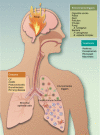Autoinflammatory disease in the lung
- PMID: 29676014
- PMCID: PMC6050210
- DOI: 10.1111/imm.12937
Autoinflammatory disease in the lung
Abstract
Ascertaining the dominant cell type driving an immunological disease is essential to understanding the causal pathology and, therefore, selecting or developing an effective treatment. Classifying immunological diseases in this way has led to successful treatment regimens for many monogenic diseases; however, when the dominant cell type is unclear and there is no obvious causal genetic mutation, then identifying the correct disease classification and appropriate therapy can be challenging. In this review we focus on pulmonary immunological diseases where an innate immune signature has been identified as a predominant aspect of the immunopathology. We describe the molecular pathology of 'autoinflammatory diseases of the lung' and propose that small molecule and biological therapies, including recombinant interleukin-1 receptor antagonist, that target key innate immune pathways, are likely be beneficial in the control of pulmonary and systemic inflammation in these conditions. In addition, the successful use of macrolide antibiotics to treat lung infections in these conditions further confirms that the innate immune system is the key conductor of inflammation in these pulmonary diseases, as there is a strong body of evidence that macrolides are able to modulate the NLRP3 inflammasome and interleukin-1β and interleukin-18 secretion, both of which are central players in the innate immune response. Throughout this review we highlight the published evidence of autoinflammatory disease in chronic obstructive pulmonary disease, bronchiectasis, cystic fibrosis and rheumatoid lung disease and suggest that the fundamental pathology of these diseases places them towards the autoinflammatory pole of the immunological disease continuum.
Keywords: COPD; autoimmunity; bronchiectasis; cystic fibrosis; inflammation; panbronchiolitis.
© 2018 John Wiley & Sons Ltd.
Figures


References
-
- McDermott MF, Aksentijevich I, Galon J, McDermott EM, Ogunkolade BW, Centola M et al Germline mutations in the extracellular domains of the 55 kDa TNF receptor, TNFR1, define a family of dominantly inherited autoinflammatory syndromes. Cell 1999; 97:133–44. - PubMed
-
- Stoffels M, Kastner DL. Old dogs, new tricks: monogenic autoinflammatory disease unleashed. Annu Rev Genomics Hum Genet 2016; 17:245–72. - PubMed
Publication types
LinkOut - more resources
Full Text Sources
Other Literature Sources

